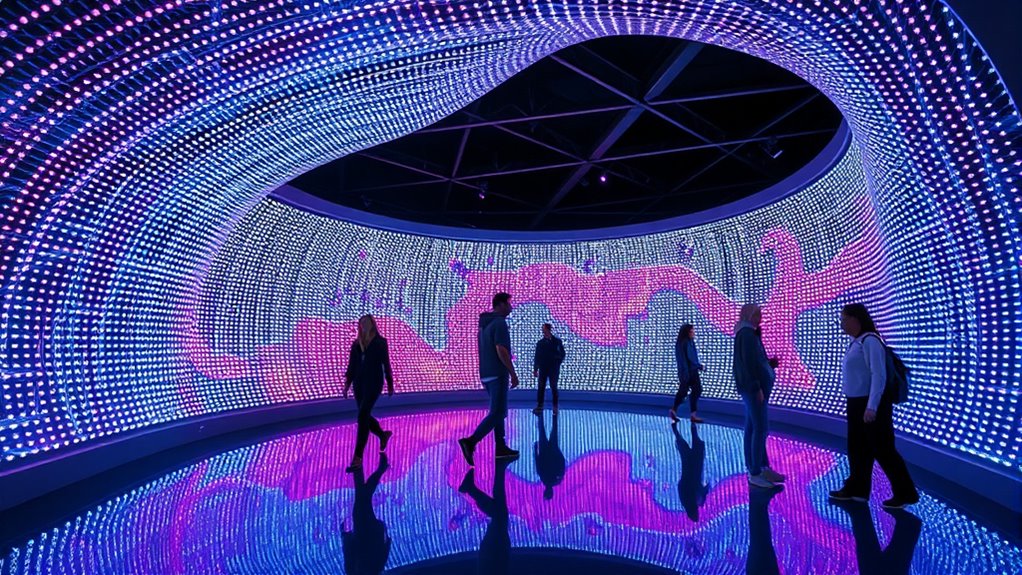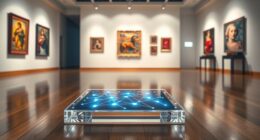Sensor-based interactive installations use technology to create environments that respond naturally to your gestures and position. By recognizing your movements and measuring your proximity, these systems react instantly with lights, sounds, and visuals, making you feel part of a dynamic space. They eliminate traditional controls, offering intuitive, personalized experiences that encourage exploration. If you keep exploring, you’ll discover how these innovations are transforming how you engage with art, spaces, and technology.
Key Takeaways
- Use advanced sensors to detect user gestures and proximity, enabling natural, responsive interactions.
- Gesture recognition translates movements into commands, differentiating intentional actions from accidental ones.
- Environmental responses dynamically change based on user distance and gestures, creating immersive experiences.
- Calibration and zone design ensure smooth, accurate system responses tailored to specific interactions.
- Commonly applied in art, museums, and public spaces to transform passive observation into active participation.

Sensor-based interactive installations harness the power of technology to create immersive experiences that respond seamlessly to user movements and actions. When you step into these environments, you become part of a dynamic system that interprets your gestures and spatial presence through advanced sensing techniques. Gesture recognition plays a vital role here, allowing the system to detect specific hand or body movements and translate them into meaningful commands or visual responses. Whether you’re waving your hand to change visuals or pointing to trigger an audio cue, the installation reacts instantly, creating a sense of direct interaction. Proximity sensing further enhances this experience by measuring how close you are to certain objects or zones within the installation. As you approach or retreat, the system adjusts its responses accordingly, making the environment feel alive and intuitive.
Sensor-based installations create immersive, responsive environments that adapt to your gestures and proximity in real-time.
You might notice how these installations respond differently depending on your distance. For instance, as you move closer, lights might intensify, sounds could become more prominent, or visual displays might shift to highlight your presence. This proximity sensing technology provides a layer of spatial awareness, making your movements more meaningful within the context of the installation. It’s almost like the environment is sensing your intentions and adapting in real-time, which deepens your engagement and immersion. You don’t need to press buttons or use traditional interfaces—your natural gestures and positioning are enough to control or influence what unfolds around you.
Designers of these systems carefully calibrate gesture recognition algorithms to distinguish intentional gestures from accidental movements, ensuring smooth and accurate interactions. They also employ proximity sensing to create zones of influence, where different effects are triggered based on your location. This integration of technologies enables installations to be both responsive and intuitive. As you explore, the system continuously interprets your actions, allowing you to experiment with different gestures to produce varied outcomes. This interaction fosters a playful, exploratory environment where your body becomes the controller. Additionally, the use of sensing technologies allows for the creation of more personalized and adaptive experiences that can cater to individual users.
Ultimately, the combination of gesture recognition and proximity sensing transforms passive observation into active participation. You’re no longer just an observer; you’re a co-creator of the experience. These sensor-based installations blur the line between technology and human movement, offering personalized, engaging encounters that adapt to your actions in real-time. Whether in art galleries, museums, or public spaces, they invite you to step in, move freely, and see how your presence shapes the environment around you. In doing so, they demonstrate how cutting-edge sensing technologies can redefine interactive experiences, making them more natural and compelling.
Frequently Asked Questions
What Are the Latest Sensor Technologies Used in Interactive Installations?
You can explore the latest sensor technologies like advanced gesture recognition systems and infrared sensing. Gesture recognition allows you to interact seamlessly by tracking hand movements or body language, creating immersive experiences. Infrared sensing detects heat signatures and motion, enabling precise interaction even in low-light conditions. These technologies enhance interactivity, making installations more intuitive and engaging, and are increasingly being integrated into modern interactive installations for a more dynamic user experience.
How Do Sensors Ensure User Privacy in Interactive Environments?
Imagine a shield of privacy safeguards wrapping around you, ensuring your personal details stay protected. Sensors use data anonymization techniques to strip away identifying information, so your movements are tracked without revealing who you are. This coincidence of technology and privacy creates a secure environment where your interactions remain confidential, allowing you to engage freely and confidently without concern that your personal data will be misused or exposed.
What Maintenance Is Required for Long-Term Sensor-Based Installations?
You need to regularly perform calibration routines to keep sensors accurate over time, ensuring they respond correctly to user interactions. Additionally, managing power effectively is vital; you should check and optimize power settings to prevent outages and extend equipment lifespan. Routine maintenance also involves cleaning sensors, inspecting connections, and updating firmware as needed. By staying on top of these tasks, your installation remains reliable, responsive, and enjoyable for users long-term.
How Can Sensors Be Integrated Into Outdoor or Harsh Environments?
Your sensors can brave the wild outdoors with proper weatherproofing and sealed enclosures—think of them as armor for the elements. To tackle weatherproofing challenges, use rugged, waterproof casing and corrosion-resistant materials. Pair that with reliable power supply solutions like solar panels or battery packs designed for harsh conditions. This combo guarantees your sensors remain operational, no matter rain, snow, or scorching heat, making your installation virtually unstoppable.
What Are Cost-Effective Options for Small-Scale Interactive Projects?
You can save money by choosing affordable sensors like ultrasonic, infrared, or capacitive touch sensors, which work well for small-scale projects. DIY sensor kits are also a great option—they’re easy to assemble and often come with everything you need. By combining these cost-effective sensors with simple microcontrollers like Arduino or Raspberry Pi, you’ll create interactive installations without breaking the bank.
Conclusion
Think of sensor-based interactive installations as a dance between you and technology, where every movement sparks a new step. Just like a conductor guides an orchestra, you direct the flow of experience through your actions. As sensors listen quietly, they transform your gestures into a symphony of interaction. Embrace this dance, where you’re both the performer and the audience, creating a seamless harmony that invites others to join in and explore the magic of connection.









